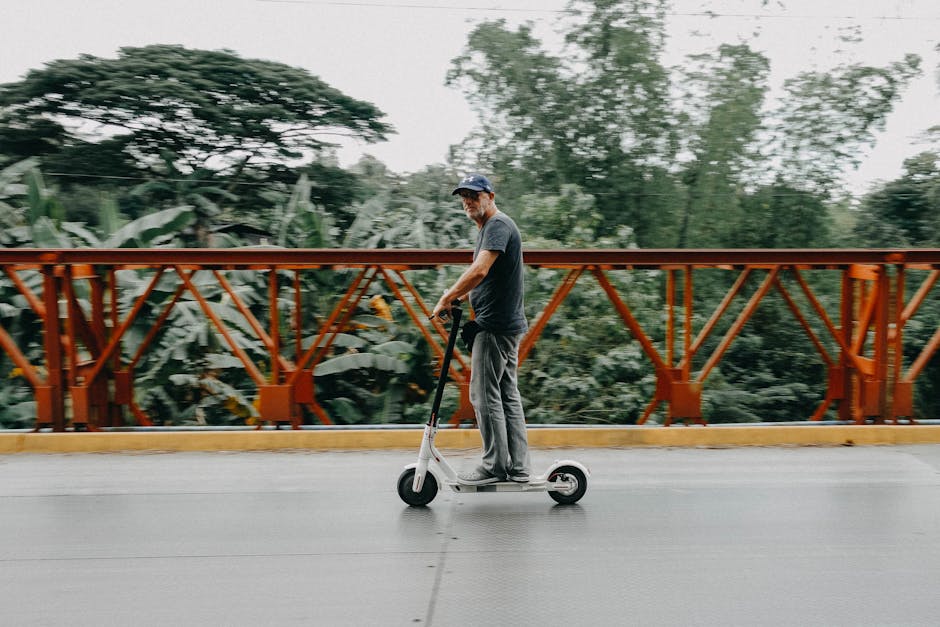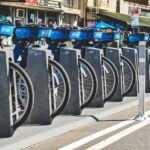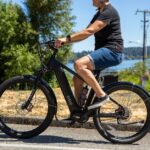Why Are Scooters So Unpopular Now?
Why Are Scooters so unpopular now? Here are the key reasons:
- Status Symbol: Many people prioritize cars for their image.
- Speed Limits and Safety: Scooters are often seen as too slow and unsafe.
- Practicality Issues: Long commutes and city layouts don’t favor scooters.
- Cultural Perception: There’s a stigma around riding scooters.
- Weather Conditions: Scooters are not ideal for harsh weather.
Once the go-to vehicle for quick urban commuting, scooters have seen a notable dip in popularity in recent years. Despite their eco-friendliness and low cost, they face stiff competition from cars, motorcycles, and even e-bikes.
In North America, scooters are often overshadowed by motorcycles, which are perceived as more powerful and appealing. Similarly, urban sprawl and infrastructure developments are not always scooter-friendly. Many cities require longer commutes, making faster, more robust vehicles a better option.
Moreover, cultural perceptions play a big role. Scooters are sometimes seen as less “cool” or even as a symbol for juveniles or inexperienced riders. This stigma, combined with concerns over speed and safety, further reduces their appeal.
Lastly, practical issues like harsh winters, licensing requirements, and parking challenges complicate the adoption of scooters as a preferred mode of transport.

Stay tuned as we dig deeper into the decline of scooters and explore if they can make a comeback.
Find more about Why Are Scooters so unpopular now?:
Wealth and Consumerism
Status Consciousness
In the U.S., consumerism and status symbols are deeply intertwined. Scooters often fall short in the status department compared to luxury cars. Many Americans equate success with owning high-end vehicles, like Mercedes or BMWs, rather than practical, economical scooters.
One Reddit user shared a personal story about being laughed at for riding a scooter. They noted that the same people who mocked them were living in crippling debt, chasing after the latest iPhones and expensive cars. This highlights how the consumerism ideology in America prioritizes lavish items over practical ones.
“Here in America, we often feel we have to put off this image of ‘success’ and the current culture doesn’t include scooters as a status symbol.”
Even among motorcyclists, scooters are viewed as “less than.” This perception stems from the idea that bigger and more powerful vehicles are inherently better and more prestigious. This cultural mindset significantly impacts the scooter market.
Economic Factors
Economic considerations also play a crucial role in the unpopularity of scooters in North America. In many parts of the world, scooters are a cost-effective mode of transportation. But in the U.S., where car affordability is relatively higher, people often opt for cars instead.
In Asia, owning a car is prohibitively expensive due to high tariffs, gas prices, and parking fees. This makes scooters a more attractive option for the working class. Conversely, in the U.S., cars are more accessible and often come with financing options that make them affordable for a broader segment of the population.

The infrastructure in the U.S. also favors cars. Long commutes and the need for highway travel make scooters less practical. Highways require vehicles that can sustain high speeds, and most scooters just aren’t built for that.
Moreover, the transportation costs associated with owning a car in the U.S. are often subsidized. This includes taxpayer-funded road maintenance and parking facilities, making car ownership more appealing and economically viable compared to scooters.
Stay tuned as we dig deeper into the decline of scooters and explore if they can make a comeback.
Practicality and Infrastructure
Urban Sprawl
In the United States, urban sprawl is a major factor contributing to the unpopularity of scooters. Unlike many European cities, which are compact and have efficient public transportation systems, American cities are often spread out. This means longer commutes and a reliance on highways, which are not scooter-friendly.
For instance, a Reddit user pointed out that some people in the U.S. commute 30+ miles each way. Scooters are not practical for such long distances, especially when the route involves highways where higher speeds are necessary.
“Some people commute for 30+ miles, each way! I can’t picture a hummer being able to steer the roads in England and other places.”
Urban sprawl forces people to rely on cars for their daily commutes, making scooters seem impractical. The layout of American cities often includes suburban areas far from business districts. This design makes it difficult for scooters to be a viable transportation option.
Speed and Safety
Speed limits and safety concerns are significant barriers to scooter adoption in the U.S. Most scooters are designed for city streets and have lower maximum speeds. In contrast, many American roads have high-speed limits that scooters can’t safely match.
For example, a 35-minute car ride to a nearby town can become an 80-minute journey on a 125cc scooter. This not only increases travel time but also exposes riders to higher risks. Being slower than the flow of traffic can be dangerous, especially on roads where cars are traveling at high speeds.
“Scooters are great for us lucky enough to live in areas in the US where it is viable as a means of transportation but those areas are far and wide between.”
Additionally, traffic regulations in the U.S. often favor cars. For instance, scooters are usually not permitted to travel on highways, limiting their utility for long-distance commutes. This makes them less appealing for daily use.
Safety is another concern. Scooters are less visible than cars and offer less protection in case of an accident. This makes them a less attractive option for many people, especially in areas with heavy traffic.
Stay tuned as we dig deeper into the decline of scooters and explore if they can make a comeback.
Weather and Climate
Seasonal Limitations
One of the dirty little secrets behind the unpopularity of scooters is the impact of weather and climate. In many parts of the U.S., harsh winter conditions make scooters impractical for several months of the year. Snow, ice, and freezing temperatures can make riding a scooter dangerous and uncomfortable.
For example, in Northeast cities like New York and Boston, winter weather can be brutal. These conditions force many scooter owners to treat their vehicles as part-time options, only usable during the warmer months. This seasonal limitation reduces the overall utility and appeal of scooters, unlike in countries with milder climates where scooters can be used year-round.
“In the UK, the roads were narrow, even the freeways had narrow lanes… Scotland was very void of scooters, the locals said it rained too much, and cages ruled there.”
Regional Variations
The impact of weather on scooter usage isn’t uniform across the United States. Southern cities like Miami and Los Angeles, which enjoy milder winters, see higher scooter usage compared to their northern counterparts. However, even in these regions, other factors like urban sprawl and highway reliance still pose challenges.
In colder states, the seasonal limitations are even more pronounced. People in these areas are less likely to invest in a scooter when they know it will sit unused for a significant part of the year. This is particularly true in places with long, harsh winters, where the cost and effort of maintaining a scooter year-round may not seem worth it.
“People in colder states don’t want to go to the trouble of getting a part-time vehicle.”
Moreover, regions with heavy rainfall or frequent storms also see lower scooter adoption. Even in some warmer states, unpredictable weather can deter people from relying on scooters as their primary mode of transportation. This further limits the market for scooters in various parts of the country.
Next, we’ll dig into the cultural perceptions that contribute to the decline of scooters in America.
Cultural Perceptions
Scooter Image
One dirty little secret about the unpopularity of scooters is tied to their image in American culture. Unlike in Europe or Asia, where scooters are seen as practical and stylish, in the U.S., they often carry a stigma. Many Americans view scooters as “cheap” or “uncool.” This perception is deeply ingrained and affects how people think about scooters.
“My job requires me to take refresher courses. I had a middle-aged lady on a big cruiser in my rider safety course refresher. The whole time this lady made jokes about my 50cc Vino and how I didn’t need to be there to ride it.”
In America, success is often measured by the kind of vehicle you drive. Luxury cars and big SUVs are seen as status symbols, while scooters are not. This consumerism ideology pushes people to opt for more expensive and flashy vehicles to project an image of success.
Even though scooters can be customized and made luxurious, the broader societal view hasn’t shifted. People still associate scooters with being less successful or financially unstable.
Motorcycle Comparison
Another aspect of the cultural stigma against scooters is how they compare to motorcycles. In the U.S., motorcycles have their own subculture and are often seen as symbols of freedom and rebellion. Scooters, however, don’t share this image. Instead, they are often viewed as toys rather than serious vehicles.
“Even motorcyclists view scooters as less than in America. They were trying to compensate by riding a bigger bike and talking down to me.”
Motorcycles are seen as more powerful, faster, and cooler. This perception makes it hard for scooters to compete. The U.S. market sees entry-level motorcycles at 250cc, which is already above most scooter capacities. This makes scooters seem inadequate for anything more than short, city rides.
“The only difference between scooters and other types of toys is that scooters also need to be practical.”
The cultural perceptions surrounding scooters in America—ranging from their image as “cheap” to being seen as toys—play a significant role in their lack of popularity. This is compounded by the strong motorcycle culture that overshadows scooters in terms of speed, power, and status.
Next, we’ll explore the regulatory and legal barriers that make scooters less appealing.
Regulatory and Legal Barriers
Licensing Requirements
One dirty little secret about the unpopularity of scooters in the U.S. involves the complex licensing requirements. Unlike cars, which only require a standard driver’s license, scooters often fall into a gray area. For instance, any scooter over 50cc typically requires a motorcycle endorsement. This means additional tests, courses, and fees.
“In the U.S., anything over 50cc and capable of going more than 30MPH is generally considered a motorcycle, requiring a motorcycle endorsement.”
This extra layer of licensing can be a significant barrier. Many people find it easier to stick with a car license rather than go through the hassle of getting a motorcycle endorsement. The effort and expense of obtaining this extra license discourage potential scooter riders.
Parking and Traffic Laws
Parking and traffic laws also play a considerable role in why scooters aren’t more popular. While scooters are smaller and more maneuverable, they often face the same parking restrictions as cars. Many cities do not offer dedicated scooter parking, making it hard to find a spot.
“Despite their small size, scooters are harder to park than cars in many U.S. cities. They are often seen as easy targets for police enforcement.”
Traffic laws can also be unfriendly to scooter riders. In most U.S. states, lane splitting (riding between lanes of slow or stopped traffic) is illegal. This is in contrast to places like California, where lane splitting is allowed and helps motorcyclists and scooter riders get through traffic more quickly.
“In the other 49 U.S. states, lane splitting is illegal and penalized with fines. So, bikes sit in traffic same as everyone else.”
Moreover, scooters are often restricted from using highways due to their limited speeds. This makes them less practical for longer commutes, especially in sprawling cities where highways are a necessity.
Enforcement Issues
Scooter riders also face strict enforcement issues. Police often target scooters for minor infractions, making them seem like a hassle to own and operate.
“Scooters are often seen as easy targets for police enforcement, perhaps with reason since there seem to be a lot of unlicensed/scofflaw riders.”
This heavy enforcement can make scooter riders feel singled out and discouraged from using their scooters regularly. The combination of strict regulations, licensing challenges, and parking difficulties creates a legal maze that many find not worth navigating.
Next, we’ll dive into the Frequently Asked Questions about why scooters are so unpopular now.
Frequently Asked Questions about Why Are Scooters So Unpopular Now?
Why aren’t scooters popular in America?
Wealth and consumerism play a big role. In the U.S., owning a car is often seen as a status symbol. Many people prefer to invest in luxury cars and other high-status items. Scooters, on the other hand, are perceived as “cheap” and not fitting into this image of success.
Winter weather also limits scooter use. In many parts of the U.S., harsh winters make it impractical to ride a scooter year-round. This seasonal limitation reduces their appeal as a primary mode of transportation.
Distance is another factor. American cities are often spread out, requiring longer commutes that scooters aren’t well-suited for. Most scooters can’t handle highway speeds, making them less practical for these longer trips.
Why don’t people like electric scooters?
Safety concerns are a significant issue. Many people worry about the visibility and stability of scooters, especially in busy traffic. Additionally, scooters are often seen as less safe than cars in accidents.
Parking issues also deter people. Despite their small size, scooters often face the same parking restrictions as cars. Finding a legal parking spot can be challenging, especially in urban areas.
Lack of regulations adds to the problem. Inconsistent laws and enforcement across different states make it confusing for riders. This regulatory uncertainty can discourage people from using scooters.
Are scooters still popular?
Globally, scooters remain popular, especially in Asia and Europe. According to recent statistics, scooters are a common sight in cities like Paris and Tokyo, where they are seen as practical and economical.
In the U.S., however, their popularity has waned. The rise and fall of companies like Bird highlight the challenges faced by the scooter industry. Despite this, there are still pockets of growth. Urban areas like Charlotte, NC are seeing an increase in scooter use.
Future projections suggest that scooters could make a comeback as cities become more congested and people look for alternative transportation options. Advances in electric scooter technology and better infrastructure could also boost their popularity.
Next, we’ll dive into the Conclusion and explore how Doot Scoot fits into the changing landscape of urban mobility.
Conclusion
As we’ve explored, the decline in scooter popularity in the U.S. can be attributed to various factors like consumerism, urban sprawl, and seasonal limitations. Yet, this doesn’t mean scooters are obsolete. In fact, they hold incredible potential for eco-friendly urban mobility, especially with the right positioning and focus.
Doot Scoot aims to capitalize on this potential by positioning itself as a leading authority in eBike and scooter reviews. Our goal is to educate and inform our audience, helping them make informed decisions about their transportation options.
Market Positioning
We are committed to establishing Doot Scoot as a niche expert in the eBike and scooter market. By offering comprehensive reviews, in-depth guides, and expert comparisons, we aim to become the go-to resource for both new and experienced riders.
Eco-Friendly Focus
Scooters and eBikes are excellent solutions for eco-conscious urban dwellers. They offer a sustainable alternative to cars, reducing carbon footprints and alleviating traffic congestion. We emphasize the environmental benefits of scooters, encouraging a shift towards more sustainable transportation options.
Urban Mobility
Urban areas are becoming increasingly congested, making traditional car travel less practical. Scooters offer a nimble, efficient way to steer crowded city streets. As cities invest more in bike lanes and other infrastructure, the practicality of scooters will only increase.
By focusing on these key areas, Doot Scoot is well-positioned to lead the charge in changing urban mobility. We invite you to explore our best deals on scooters and eBikes and join us in making our cities cleaner, greener, and more efficient.
Thank you for reading! We hope this article has shed light on why scooters are so unpopular now and how Doot Scoot is working to change that narrative. Stay tuned for more insights and updates from urban mobility.










